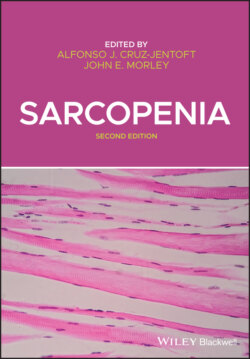Читать книгу Sarcopenia - Группа авторов - Страница 19
MATURITY OF SARCOPENIA: RECENT DEFINITIONS
ОглавлениеA decade later, the EWGSOP met again, with a wider academic support (adding the endorsement of International Osteoporosis Foundation [IOF] and European Society for Clinical and Economic Aspects of Osteoporosis, Osteoarthritis and Musculoskeletal Diseases [ESCEO] to ESPEN and EuGMS) to review and update the 2010 definition and reflect the advances in scientific, epidemiological, and clinical knowledge, and to facilitate the implementation of sarcopenia in mainstream clinical practice [20]. The updated consensus definition, named EWGSOP2, states that a person with low muscle strength and low muscle mass or quality will be diagnosed with sarcopenia. When sarcopenia impairs physical performance measures, it will be staged as severe sarcopenia. Sarcopenia is now understood as an organ (skeletal muscle) failure or insufficiency [21] that may appear acutely (in the setting of an acute disease or sudden immobility) or have a more chronic course. It aligns with the new function‐centered model proposed by the World Health Organization that focuses on intrinsic capacity (defined as a composite of all physical and mental capacities of an individual) [22].
The three main advances of the EWGSOP2 definition result from new insights: (i) sarcopenia is no longer considered primarily as a geriatric syndrome but as a muscle condition with an ICD‐CM diagnosis code (ICD‐10‐CM M62.84); (ii) loss of muscle quality is introduced as a new diagnostic criterion; and (iii) muscle strength is recognized as the best predictor of health outcomes. This definition intends to introduce sarcopenia in wide‐stream clinical practice as well, by offering a simple diagnostic algorithm. The AWGS has also published and updated definition [23]. Australia and New Zealand have opted to endorse the EWGSOP definitions [24]. Similar definitions focusing on the loss of strength or function in combination with a loss of lean mass have been published by the Society of Sarcopenia, Cachexia and Muscle wasting [25] and by the International Conference of Frailty and Sarcopenia Research [18]. Both also strongly recommended resistance exercise and the major treatment modality.
On the American side, the Sarcopenia Definition and Outcomes Consortium (SDOC) was funded by the National Institute on Aging (NIA) in 2015 with additional support of the FNIH. The SDOC aim is to develop evidence‐based diagnostic cut‐off points for lean mass and/or muscle strength that enable identification of people at risk or mobility disability as a target population of potential function‐promoting therapies [26]. As in the FNIH initiative, the SDOC is again using an epidemiological approach using several cohorts, mostly in the United States but also in Europe, in order to accumulate data from a large number of subjects and be able to calculate an algorithm predictive of sarcopenia outcomes. The project was completed in August 2019, and the final document with recommendations published in 2020 [27].
Sarcopenia is now extending well beyond older age, with recent initiatives trying to define sarcopenia within organ diseases [28] and even in pediatrics [29].
A global (European, Asian, American, and Australia/New Zealand) initiative is now in process to try to come to a consensus on an operational definition of sarcopenia that would finish this long trip.
